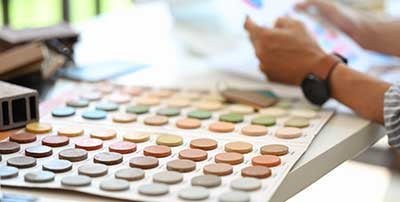The Art of Color-Centric Room Design: Creating Harmony with One Specific Hue
In the world of interior design, color holds the power to transform spaces, evoke emotions, and create a cohesive atmosphere. One of the most striking techniques for achieving a harmonious look is organizing the decor of a room around a single color. This approach not only simplifies the design process but also allows for a more focused and impactful aesthetic. By exploring insights from renowned designers and practical budget-friendly strategies, this guide will help you master the art of single-color room decor.
The Power of Color
Color is more than just a visual element—it’s a powerful tool that influences the mood and perception of a space. As American designer Kelly Wearstler aptly puts it, "Color is the most powerful tool in the designer's toolkit. When used intentionally, it creates spaces that feel both intentional and cohesive." By selecting one color as the central theme, you can achieve a unified look that feels deliberate and sophisticated.

European designer Marie Olsson Nylander echoes this sentiment, noting, "A singular color theme allows a space to breathe, making it feel more curated and less chaotic." When done correctly, a monochromatic scheme can make a room feel larger, more cohesive, and distinctly personal.
Choosing Your Color
The first step in creating a color-centric room is selecting the right hue. The choice should reflect the room's purpose and the ambiance you wish to create:
|
|
|
- Neutral Whites and Grays: These shades work well in modern or minimalist spaces. They provide a clean backdrop that allows other design elements, such as textures and patterns, to stand out.
The Art of Budget-Friendly Color-Centric Decor
Designing around a single color can be cost-effective when approached thoughtfully. Here are some budget-friendly strategies to help you achieve a stunning result without overspending:
- Paint and Wall Treatments
Painting is one of the most economical ways to introduce a color theme to a room. A fresh coat of paint can dramatically alter the mood of a space. For those on a tight budget or renting, consider removable wallpaper or decals. These options provide a similar effect without the permanence of paint.
Nate Berkus, a well-known American designer, highlights the impact of paint: “Paint is the most economical way to change the mood of a space. It’s an investment that pays off instantly.” A carefully chosen paint color can set the tone for the entire room and establish a strong foundation for your design.
- Textiles and Fabrics
Incorporating color through textiles is an affordable and flexible approach. Consider using curtains, cushions, rugs, and throws in your chosen hue. Textiles can be found at budget-friendly stores and can be easily swapped out if you want to change your color scheme later.
|
Emily Henderson, a prominent interior designer, suggests, “Textiles are a quick and cost-effective way to introduce and amplify your chosen color.” By layering different textiles, you can add depth and interest to your space without spending a fortune.
|
Henderson’s “Styled” is a New York Times bestseller. |
- DIY Projects
Getting creative with DIY projects can significantly cut costs while adding a personal touch to your decor. Consider painting old furniture, reupholstering chairs, or creating your own artwork in your chosen color. These projects not only save money but also allow you to customize your space to reflect your personal style.
Jonathan Adler, a designer known for his bold use of color, emphasizes, “Personal touches not only save money but also make the space feel uniquely yours.” DIY projects offer an opportunity to infuse your personality into your home while sticking to a budget.
- Accessorize Wisely
Accessories are an excellent way to reinforce your color theme. Look for vases, lamps, picture frames, and decorative objects in your chosen color. These items can be found at affordable prices and can help tie the room together.
Celerie Kemble, an interior designer renowned for her elegant spaces, says, “Accessories are the jewelry of the home. They offer a low-cost way to add color and style.” By choosing accessories that complement your color scheme, you can enhance the overall look of the room without significant expense.
- Repurpose and Upcycle
Repurposing existing items is a savvy way to incorporate your chosen color without spending a lot. Repaint old furniture, update hardware, or use fabric dye to give new life to worn items. Upcycling not only saves money but also contributes to a more sustainable lifestyle.
Patricia Urquiola, a celebrated European designer, notes, “Playing with tonal variations of a single color can create a rich, layered look without the need for expensive materials.” By creatively reusing and updating items you already have, you can achieve a high-impact look on a budget.
The Benefits of Monochromatic Design
Opting for a single-color scheme offers several advantages:
- Cohesion and Harmony: A monochromatic color scheme creates a cohesive and harmonious look, making the space feel more intentional and well-designed.
- Visual Simplicity: Simplifying your color palette reduces visual clutter, creating a more serene and organized environment.
- Flexibility: A single-color theme can be easily updated with new accessories or textiles, allowing for easy changes without a complete redesign.
- Focus on Details: With a unified color scheme, the focus shifts to other design elements such as texture, pattern, and form. This can lead to a more nuanced and sophisticated look.
Real-Life Examples
Many successful interior designs showcase the power of single-color schemes. For instance, a living room dominated by various shades of blue can evoke a calming and cohesive atmosphere. Similarly, a kitchen outfitted in vibrant green can create an energetic and inviting space. These real-life examples demonstrate how a focused color approach can yield beautiful and functional results.

Conclusion
Organizing a room’s decor around a single color is a powerful design strategy that can bring harmony and style to any space. By selecting the right hue and employing budget-friendly techniques, you can create a cohesive and visually striking environment. As Michael S. Smith, an influential designer, puts it, “Color is not just a detail, but the essence of design. When it’s used well, it can be transformative.”
Embrace the elegance of single-color decor and let your chosen hue guide you in creating a room that reflects your personal taste and enhances your living space. Whether through paint, textiles, DIY projects, or accessories, a well-executed color scheme can turn any room into a beautifully curated retreat.









